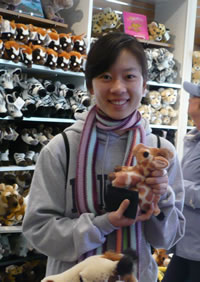


Why NanoJapan?
NanoJapan gave me the unique opportunity to combine both a scientific research experience and a study abroad experience. I am interested in studying nanotechnology, and through this program, I’ve learned a lot about the field and also about what doing research is like. After this summer, I plan on continuing doing similar research because I really enjoyed what I did. This program was also unique in that it targets first and second year college students, which is great because it lets us see what research and nanotechnology and study abroad are like early on. Japan is an amazing place to spend a summer with so many places to visit, sights to see, and people to meet. It was cool to live in a totally different environment for three months, and I will definitely pursue other international opportunities in the future.
Research Project Overview - "Optical and Terahertz Spectroscopy of CdSe/ZnS Quantum Dots" ![]()
My research focused on characterizing the electronic and vibrational properties of CdSe/ZnS core/shell quantum dots using optical and terahertz spectroscopy. I started the project by doing basic optical spectroscopy measurements on gases before doing temperature dependent emission spectroscopy of the quantum dots and then doing temperature dependent terahertz spectroscopy of the quantum dots. I am interested in the nanoengineering and photonics specialization of Rice’s ECE major, and this experience taught me about nanotechnology and about what studying it was like. I really liked doing the experiments and learning about the various spectroscopy techniques as well as the different properties of nanoparticles, so I plan on doing similar research in the future.
My lab was very international. Most of the lab consisted of Japanese students, but there were also students from India, France, and Nepal. My labmates were really friendly, so it was a lot of fun hanging out with them and learning about their various experiences and their plans for the future. Most of my lab mates wanted to be researchers while some wanted to go into industry, so it was interesting to hear about the different paths they were taking or planning to take and also how they got into their specific branch of research.
Michelle Jin Presents at the 2009 RQI Summer Research Colloquium
Michelle Jin gave a poster presentation on Terahertz Spectroscopy of Semiconductor Quantum Dots at the 2009 RQI Summer Research Colloquium on Friday, August 7, 2009.

Daily Life in Japan
I usually would go for a run or maybe a bike ride around after I woke up and before I ate breakfast (usually bread and milk or juice from the nearby konbini or bakery). Then I would talk with friends or parents back home on Skype. I would arrive in lab around 10 am after a 10 minute bike ride there. From then until lunch time, I usually read more about my research, did some analysis of my experimental data, or I would ask my labmates questions about things I didn’t understand. They were really helpful in answering my specific questions and great in explaining concepts to me. For lunch, I ate with my lab mates at the school cafeteria. I knew some kanji characters, but not enough to really know what was what when ordering food at the cafeteria, so my lab mates would help me with describing what the menu items were. By the end of the first week, I thought I had pretty much memorized which kanji characters matched up with which food item and would be able to order food by myself, but the next week, the menu changed completely. Apparently, the menu changes at the beginning of every week, and even on the last week, I still needed my lab mates' help. In the afternoon, I usually completed my experiments. In the evening, the time that I left from lab varied. When I had Japanese classes, which I took twice a week, I would leave around 6 pm from lab and bike to the Kyoto International Community Center, which offered 1 and 1/2 hour volunteer classes during the week. On days where I had experiments, I usually stayed later (between 8 to 10 pm) because the experiments took a while as, in addition to the actual data taking, the set up could take a long time.
I went exploring every weekend. Kyoto is such an incredible place to be because it is so rich in Japanese culture, and very convenient to get around. My lab lent me a bike, which is pretty much all you need for getting around in Kyoto. For four weekends, I just went around Kyoto on bike to temples and shrines, the Gion district, Arashiyama, the International Manga Museum, various temple markets and festivals. My lab mates were awesome and took me to visit many of these places and events, and it was cool to learn about the places I visited from them. The Kansai region is also packed with great places to go, and on the days I wasn’t in Kyoto, I went to Osaka, Kobe, and Nara. During my last few days, I used my week long JR Pass to travel to Hiroshima, Miyajima, Shikoku, Himeji, and then Mt. Fuji before heading back to Tokyo.
My Favorite Experiences in Japan were...
Before I left for Japan I wish I had...
While I was in Japan I wish I had...
Tips for Future NanoJapan Participants